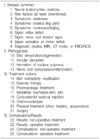Abstract
Purpose
This study evaluated the information quality of websites that provide information about herniated intervertebral discs (HIVD) and examined the correlation between the information quality score (IQS) and the rank of popularity.
Materials and Methods
From April 1 to May 31, 2005, of 308 homepages that had been searched on three search engines using the key words (vertebra, disc, lumbago, HIVD), 150 homepages with information about HIVD were surveyed. The informational quality score of each homepage was examined according to the existence or nonexistence of 25 criteria and compared the IQS according to the discipline and operating scale. The homepages were rated according to the rank of popularity and the correlations between their point of popularity and informational quality were assessed.
Results
The mean IQS of the 150 homepages were 8.5 (±6.4) points, IQS of 94 (62.6%) homepages were <10 points. There were no significant differences between the IQS of orthopedic surgery and neurosurgery (p=0.985). However, the IQS of oriental medicine were significantly lower than orthopaedic surgery (p<0.001) and neurosurgery (p<0.001). There was no significant correlation between the popularity and IQS (p=0.256).
Figures and Tables
Table 1
Criteria of the Informational Quality Score according to the United States Department of Health and Human Services

Table 4
Informational Quality Score according to the Popularity Score and Discipline

IQS, informational quality score; SD, standard deviation; OS, orthopedic surgery; NS, neurosurgery; OM, oriental medicine; Oth, the others; *Compared IQS between popularity score≥1 and=0 using Student's t-test, †Compared IQS between OS, NS, OM and Oth using ANOVA test according to popularity score. ‡There were significant differences between the disciplines in the group of the popularity score=0, each p values were 0.001 (between OS and OM), 0.011 (NS and OM), <0.001 (OS and Oth), 0.004 (NS and Oth), 0.992 (OS and NS), 0.993 (OM and Oth).
References
1. Beredjiklian PK, Bozentka DJ, Steinberg DR, Bernstein J. Evaluating the source and content of orthopaedic information on the internet. The case of carpal tunnel syndrome. J Bone Joint Surg Am. 2000. 82:1540–1543.
2. Chang MC, Kim CD, Roh HR, Chae GB, Choi WJ. Analysis of surgical websites in Korea. J Korean Surg Soc. 2003. 64:1–5.
3. Chun BC. E-health and internet in medicine: a strategic perspective. J Korean Med Assoc. 2002. 45:4–16.
4. Eysenbach G, Kohler C. How do consumers search for and appraise health information on the world wide web? Qualitative study using focus groups, usability tests, and in-depth interviews. BMJ. 2002. 324:573–577.

5. Greene DL, Appel AJ, Reinert SE, Palumbo MA. Lumbar disc herniation: evaluation of information on the internet. Spine. 2005. 30:826–829.
6. Health on the net foundation. http://www.hon.ch/HONcode/Conduct.html.
7. Huberman BA, Pirolli PLT, Pitkow JE, Lukose RM. Strong regularities in world wide web surfing. Science. 1998. 280:95–97.

8. Inews24. http://news.naver.com/news/read.php?mode=LSD&-office_id=031&article_id=0000021138 §ion_id=105&menu_id=105.
9. iProspect. http://www.iprospect.com/media/press2004_04_20.htm.
11. Ministry of Information and Communication. http://www.mic.go.kr/index.jsp.
12. O'Connor JB, Johanson JF. Use of the web for medical information by a gastroenterology clinic population. JAMA. 2000. 284:1962–1964.
13. Shin HJ, Yoon SM, Oh SY, Oh JK. The analysis of the present status of the medical internet sites in Korea. J Korean Acad Fam Med. 2000. 21:792–800.




 PDF
PDF ePub
ePub Citation
Citation Print
Print




 XML Download
XML Download